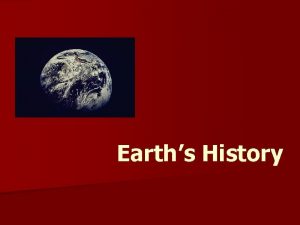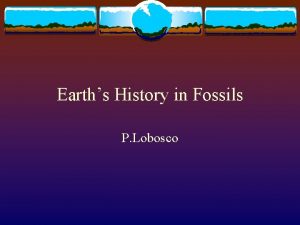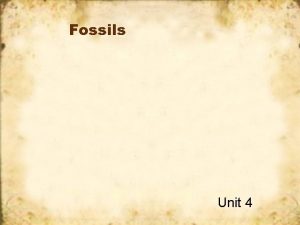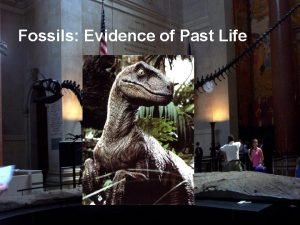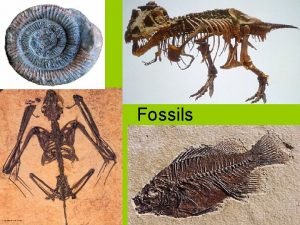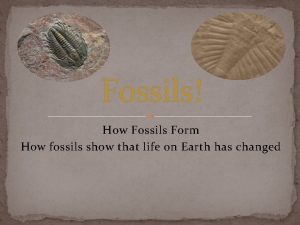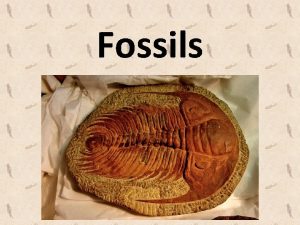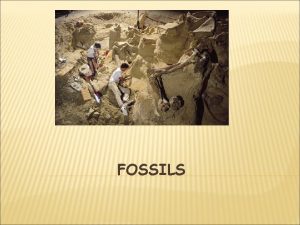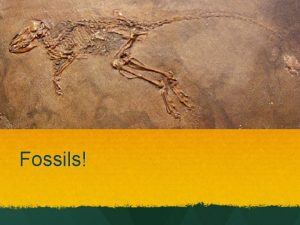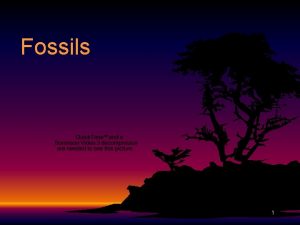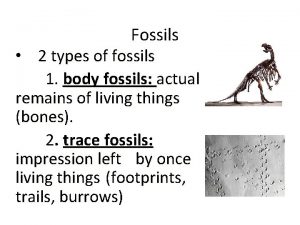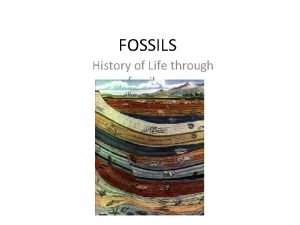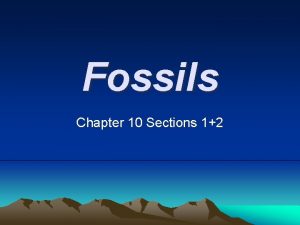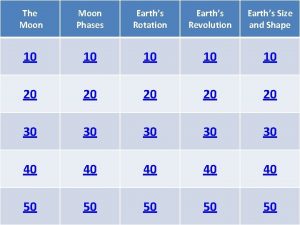Chapter 4 Earths History 4 1 Fossils https


















- Slides: 18

Chapter 4 Earth’s History

4. 1 Fossils https: //www. youtube. com/watch? v=z. HM 3 J 6 igf. Z 8 Fossils form when living things die and are buried by sediment. As the sediment compacts and cements into sedimentary rock, it preserves the shape of the organism. The soft part (flesh) of animals usually breaks down quickly or is eaten, so the most common fossils are those of bones or teeth. Most fossils form from animals or plants that live in or near calm water, like swamps, lakes, or shallow seas where sediment can deposit.


TYPES OF FOSSILS There are five different types of fossils Molds and Casts Petrified Carbon Trace Fossils Films Fossils Preserved Remains

Molds and Casts Molds: hollow area in sediment in the shape of an organism or part of an organism. Cast: when water deposits minerals and sediment into a mold.

BELLRINGER What Is the difference between a Mold and a Cast? How are they related?

Petrified Fossils Petrified means “turned into stone”, so these type of fossils form when MINERALS replace ALL of an organism, or a part such as a dinosaur bone. Wood chunks can also be petrified, since water (which carries minerals) can seep into the plant’s cells and into cracks in the wood, when the water evaporates it leaves these minerals behind.

Carbon Films Extremely thin coating of CARBON on rocks. When an organism dies and is eventually covered in sediment, some gases escape, leaving carbon behind. This process can preserve even soft parts of plants and insects.

Trace Fossils One example is fossilized footprints, where a footprint is buried by sediment and them becomes solid rock. Trail and burrows (tunnel like holes made by animals) can also become fossilized. These fossils can give evidence of the activities of these animals when they were alive.

What do Fossils Show? Evidence of the history of life and past environments and how living things have changed over time Scientists can use fossils to build a picture of what the environment looked like millions of years ago. One example is coal found in Antarctica, coal forms only from dead plants that grow in warm swampy regions, so Antarctica must have been much HOTTER than it is today at some point.

Change and the Fossil Record The fossil record is extremely important when studying evolution: the change of organisms over long periods of time. Its shows that millions of organisms evolve over time, but those that cant evolve fast enough to “Keep Up” end up going extinct: when organisms no longer exist and will never live again.

Relative Age of Rocks Scientists can use rocks and fossils to get an idea of the age of a one rock compared to another, this is Relative Dating. Remember how sediment piles up and pressure builds up it forms ____ rocks? And how these types of rocks can contain fossils in them? So think about this, if this type of rock forms as sediment piles up, do you think the older rocks will be at the bottom or near the surface? http: //study. com/academy/lesson/what-is-relative-dating -law-of-superposition-principles-of-original-horizontalitycross-cutting-relationships. html


LAW OF SUPERPOSITION IF A BODY OF ROCK IS UNDERSTURBED (NO FOLDING, PULLING APART, BREAKING ETC. ) IN HORIZONTAL SEDIMENTARY ROCK LAYERS, THE OLDEST ROCK IS AT THE BOTTOM, AND EACH HIGHER LAYER IS YOUNGER THAN THE ONE BELOW IT.

Clues from Igneous Extrusions and Intrusions. Lava that hardens on the surface and forms igneous rock is an EXTRUSION, this rock is always younger than the rock below it. Intrusions form when magma pushes through layers of rocks and cools into igneous rock. Intrusions are also always younger than the rocks they push into, how do we know that?

Clues from Faults

Index Fossils http: //study. com/academy/lesson/relative-dating-with-fossils-index-fossilsas-indicators-of-time. html

Absolute Dating To get the ABSOLUTE, or EXACT age of rocks scientists use radioactive isotopes. What are radioactive isotopes? They are versions of elements that release particles and energy in a process called radioactive decay. These elements decay at a constant rate that never changes called the HALF-LIFE, which is the time it takes for half of the atoms to decay. https: //www. youtube. com/watch? v=ph. Ze. E 7 Att_s https: //www. youtube. com/watch? v=Kcuz 1 Ji. Mk 9 k
 Chapter 21 fossils and the rock record answer key
Chapter 21 fossils and the rock record answer key Earths layers foldable
Earths layers foldable Earths roation
Earths roation Whats a natural satellite
Whats a natural satellite What makes one biome different from another?
What makes one biome different from another? Periodic table of elements families
Periodic table of elements families How thick is the earths crust
How thick is the earths crust Whats earths moon called
Whats earths moon called Thickest layer of the earth
Thickest layer of the earth Earths early atmosphere contained
Earths early atmosphere contained Dinah earth's layers foldable
Dinah earth's layers foldable Earths major crustal plates
Earths major crustal plates Earths orbit seasons
Earths orbit seasons Brown earths
Brown earths Study of the earth's physical features
Study of the earth's physical features Earths honey
Earths honey Whats the name of earths moon
Whats the name of earths moon Continental drift theory notes
Continental drift theory notes Earths crust
Earths crust



















